#SonyBraviaXRA90J
Explore tagged Tumblr posts
Text
Hisense Dual Cell technology vs mini LED backlit Review

As known, the picture quality depends significantly on contrast, which is the ratio of the panel's peak brightness to the minimum black. Contrast provides image clarity and sharpness, colors saturation, etc. As a consequence, companies focus their efforts in this direction. Self-emitting LEDs in OLED and micro LED panels operate without backlit, formally delivering infinite contrast due to perfect blacks.

OLED vs LED LCD TV image quality Indeed, the LED does not emit without a control signal, providing a completely black pixel. But OLED TVs are more expensive and less bright vs LCD. Even modern premium OLED models deliver up to 800 nits peak brightness. However, the brightness of some even mid-budget LCD panels reaches 1000 nits. On the other hand, LG this year unveiled LG G1 OLED series with the innovative Evo OLED panel, which peak brightness can exceed 1,000 nits. Micro LED panels offer impeccable quality, but they are insanely expensive, and their size starts at 100 inches on the diagonal. For example, the price of presented at CES 2021 110-inch Samsung Micro LED panel reaches $ 156,000.

Samsung Micro LED panel CES 2021
LCD TVs
Until recently, models based on OLED and Micro LED technologies belonged to the premium segment, with little overlap with the segment of significantly cheaper LCD TVs. But manufacturers of LCD TVs also did not waste time, actively improving the image quality through innovative technologies. As a result, the situation is changing today. Already this year new LG OLED TVs and Samsung Neo QLED TVs with mini LED backlit was in the same price segment. Modern LCD TVs use Quantum Dot (QD) technology to increase peak brightness and expand color gamut, and Local Dimming to enhance contrast by increasing black depth. Local Dimming enhances contrast by reducing backlit intensity in different frame areas depending on the content. Until this year, FALD (Full Array Local Dimming) was the most effective technology. But at CES 2021, TCL, LG and Samsung unveiled a new generation of mini LED backlit that uses tens of thousands of miniature LEDs grouped into thousands of Local Dimming zones. In fact, the TV market has formed a new segment of LCD TVs with QD display and mini LED backlit, which today includes Samsung Neo QLED, LG QNED and TCL OD-Zero TVs.

mini LED backlit Hisense and Panasonic have gone the other way, enhancing the contrast of LCD TVs with an optional monochromatic LC layer. These technologies are named Hisense Dual Cell (ULED XD) and Panasonic MegaCon.
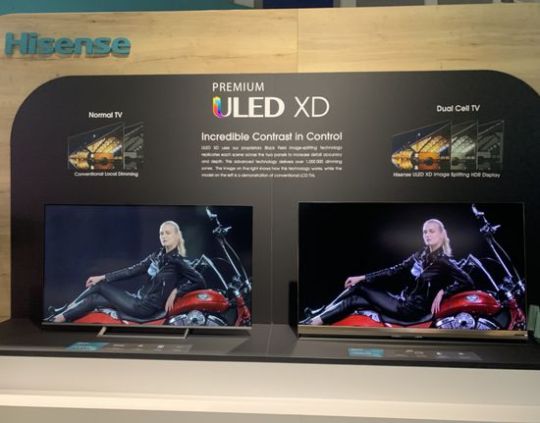
Hisense Dul Cell technology
Hisense Ultra LED (ULED)
Virtually all industry leaders use proprietary names for their QD models. This technology provides Wide Color Gamut, which directly affects picture quality and HDR performance. Simplistically, this a very elegant solution dramatically improved the white quality of the LED backlit and overall picture quality in LCD TVs.

Quantum Dots image quality As known, only the sun provides ideal white. In fact, the developers of QD technology have created an analogue of a small sun by generating artificial white in TV. For this purpose, an additional film is placed between the blue diodes on the backlight panel and the subpixel color filter. It has randomly deposited two types of nanoparticles, the sizes of which correspond to the wavelengths of green and red. Nanoparticles absorb blue and emit red and green. At the output, they are blended with unabsorbed blue to produce a higher quality white that is sent to a subpixel color filter.
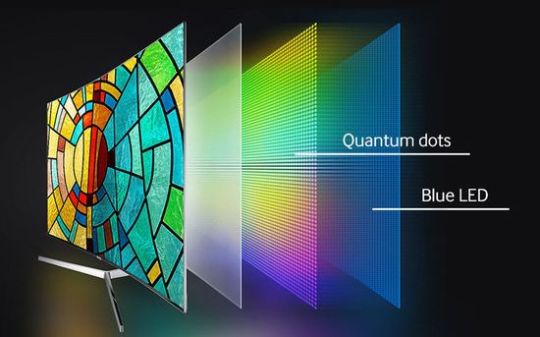
Quantum Dots technology Today the market offers Samsung QLED, Sony Triluminos, LG NanoCell TVs with this technology. Other companies often just indicate "QD display". Most of them use QDEF (Quantum Dot Enhancement Film) from California-based Nanosys, which has confidently dominated this segment, developing quantum dot materials for displays since 2001. Hisense is no exception and also uses the ULED (Ultra LED) name for its TVs with QD. In fact, ULED models include innovative solutions based on 20 different patents and can be divided into four main subgroups: - Ultra Wide Color Gamut (QD display with Nanosys QDEF, 99.98% DCI-P3); - Ultra Local Dimming; - Ultra 4K Resolution (3840 x 2160 or 2160p); - Ultra Smooth Motion Rate (frame interpolation algorithm).
Local dimming
As known, the LCD panel uses the dependence of the light transmission on crystal polarization. In turn, the polarization depends on the electric current, the supply of which is regulated through the transistor. But initially, the luminous flux is formed by the backlit. In fact, LEDs create light, which is partially absorbed by liquid crystal layer controlled by transistors, creating a color image. Unfortunately, crystals only partially block the luminous flux from the backlit even for black LCD pixels. Some light always leaks through. As a result, LCDs have always had worse black levels and, accordingly, contrast compared to OLED. In fact, Local Dimming is the main and only way to solve this problem. It's based on reducing the radiation intensity of individual groups of LEDs (Local Dimming zones). Of course, competition is forcing industry leaders to actively improve this technology. As a result, direct backlit has been improved to FALD (full-array local dimming), which in turn has been improved to mini LED backlit.

FALD (full-array local dimming)

Mini LED local dimming The innovative mini LED backlit uses a huge number of miniature LEDs combined into thousands of individually controlled local dimming zones. Moreover, over several years, the Chinese giant TCL has developed and presented three generations of this technology. The triumphant dominance of this technology in LCD TVs has become one of the trends of CES 2021. LG QNED, Samsung Neo QNED TVs and presented in March TCL X12 8K OD-Zero Starlight Smart Screen have actually formed a new segment of LCD QD TVs with Mini LED backlit. Moreover, LG OLED & Samsung Neo QLED TVs with roughly the same picture quality, compete in the same price segment, despite different display technologies (OLED vs LCD QLED).
Hisense Dual Cell or ULED XD technology
Instead of improving the Local Dimming with LED backlit, Hisense and Panasonic have come up with an ingenious alternative solution by adding an additional monochromatic LCD layer or light-modulating cell.

Hisense ULED XD Its black areas block out excess light, dramatically increasing the black depth on the screen. In fact, Dual-layer LCD with Dual Cell technology uses a second monochromatic LC layer ("luminance" module) to predimming the light from backlit in the corresponding frame areas. Then, the modulated luminous flux is directed to RGB layer ("color" module).
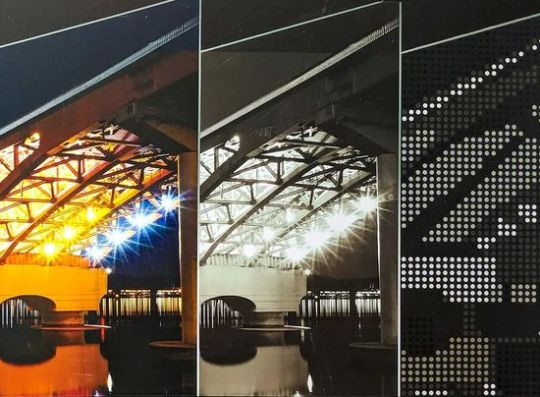
Hisense Dual Cell The figure illustrates a dual-layer LCD operation principle, where local dimming backlit is displayed right, luminance-controlling LCD layer - in middle, and color-controlling LCD layer - left. Technically, this technology only requires the addition of film, and should not drastically increase their price.
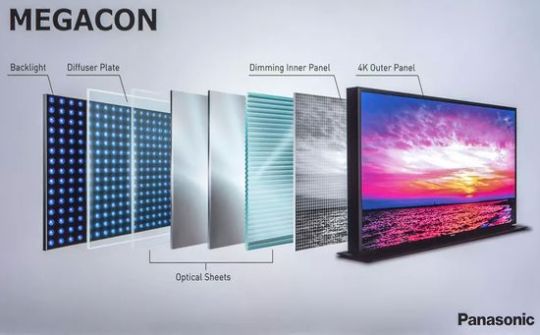
Panasonic Megacon In fact, ULED XD precision-bonds two LCD modules together, one of which handles the luminance information (black and white only), second - colors. In May company presented a prototype with a monochromatic luminance module of HD resolution in combination with a 4K color module (over 2 million pixels). But Hisense promises to increase the resolution of the luminance module to 4K (3,840 x 2,160). In fact, this technology can be positioned as local dimming on the pixel level with 8.3 million zones! According to the company, ULED XD TVs will also use standard local dimming with 132 zones, which will provide an overall native contrast ratio of 1,000,000: 1! Hisense also lists the black level of ULED XD up to 0.00003 nits and a peak light output over 1,000 nits. Additionally, QD technology provides 100% DCI P3 & 84% Rec 2020, and native refresh rate for both panels is 120Hz. As known, Hisense uses Android TV OS.
Conclusion
Preliminarily, 75-inches Hisense Dual Cell U9DG will be available already this summer for $ 3,500. Probably, many experts are eagerly awaiting the opportunity to compare Hisense Dual-Cell U9DG TV with the best OLED models (for example, Sony Bravia XR A90J or LG G1 Gallery Series) and with the best LCD TVs with QD & mini LED backlit (for example, LG QNED, TCL OD-Zero, or Samsung Neo QLED TVs.) Given the declared 2,000,000 Local Dimming zones & peak brightness of 1,000, the image quality and HDR performance of the new Hisense Dual-Cell U9DG leaves no chance for other competitors. But overwhelming advantage of any technology is unlikely. Maybe ophthalmologists can tell us the maximum perceived contrast. Probably, many people remember the smooth fading of the agitation around the resolution. According to many ophthalmologists, our vision ceases to perceive the difference between 4K and 8K resolution from a distance of a meter or more. Sophisticated research by South Korean scientists was only able to reveal "subconscious perception", when many subjects could not distinguish between 4K and 8K, but the coffee in the 8K image seemed to them "more hot". However, the comparison results will provide some answers: - will OLED TVs retain the lead with the brighter innovative Evo OLED panel (LG G1) in picture quality? - what will be the real increase in contrast, taking into account the price of mini LED backlit (Samsung Neo QLED, LG QNED and TCL OD-Zero) vs Dual-Cell technologies (Hisense and Panasonic). But, of course, regardless of the comparison results, the consumer market will benefit. This video offers a presentation on Hisense Dual Cell Technology. Read the full article
#dual-layerLCDoperationprinciple#EvoOLEDpanel#FALD#full-arraylocaldimming#HisenseDualCelltechnology#HisenseU9DG#HisenseULED#HisenseULEDXDtechnology#LGG1GallerySeries#LGQNED#LocalDimming#MiniLEDbacklit#PanasonicMegaCon#SamsungNeoQLED#SonyBraviaXRA90J#TCLOD-Zero#TCLX128KOD-ZeroStarlightSmartScreen
0 notes
Text
LG OLED vs Samsung Neo QLED TVs 2021 Review
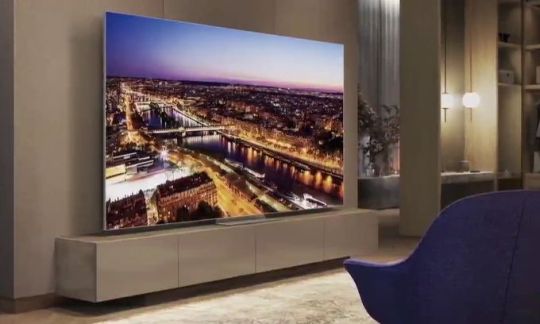
The heated debate about pros & cons LCD vs OLED technology has been going on for many years. However, they were quite academic in nature, since LCD & OLED TVs were in different price segments. But LG's efforts to reduce the OLED panel price and the progress of LCD TVs manufacturers to improve picture quality (QLED + Local Dimming with Mini LED backlit) are dramatically changing the situation.
OLED vs LCD 2021
This year, models based on these technologies are for the first time in the same price segment, sharply exacerbating the discussion. This year, models based on these technologies have mixed in the same price segment, which sharply exacerbates the discussion. In the segment from $ 2,000 to $ 3,000, the market today offers five quite comparable in price and quality TVs from the industry leaders. This list includes: - LG OLED 65CX (2020) - $ 2,000; - Samsung Neo QLED 65QN85A (2021) - $ 2,200; - LG OLED 65C1 - $ 2,500; - Samsung Neo QLED 65QN90A - $ 2,600; - LG OLED 65G1 - $ 3,000. Differences within the lines: - unlike the new C1 & G1 with webOS 6.0, last year's LG CX has webOS 5.0 version, does not have new Magic Remote, and uses the α9 Gen 3 AI Processor 4K, which is inferior to the more performance α9 Gen 4; - LG 65G1 - the first and only model today with an innovative OLED Evo panel, the brightness of which is increased to 1,000 nit. New Evo OLED panels use an additional third green emitter layer.
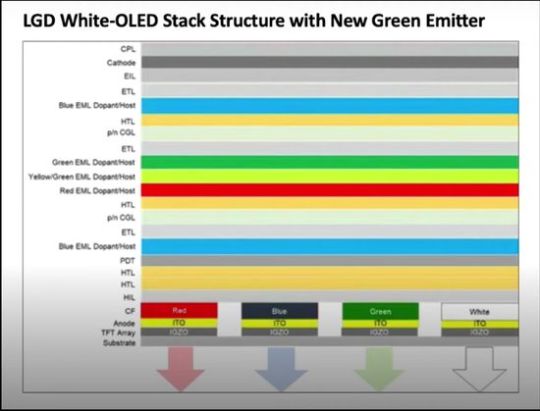
Evo OLED panel Combined with red and yellow-green, this structure extends panel color gamut. Moreover, DuPont makes blue emitters from the more productive deuterium instead of hydrogen. Its improved performance allowed designers to increase panel brightness at the same amperage and, accordingly, without reducing panel life due to overheating; - flagship Samsung 65QN90A uses a brighter VA panel with very high contrast ratio, QN85A uses ADS (Advanced Super Dimension Switch) panel with wider viewing angles, which is an improved IPS matrix. A short introduction with main key features of modern TVs will help you more objectively assess the prospects for this year's potential bestsellers.
OLED & Micro LED panels
About five years ago, the evolution of TVs split into two directions. LG and Sony have focused on developing innovative OLED technology that uses self-emissive pixels and therefore does not require backlit. This eliminated the problem of imperfect blacks due to partial transmission of light through the matrix in transmissive LCD panels. The fantastic contrast has become the main advantage of this technology.
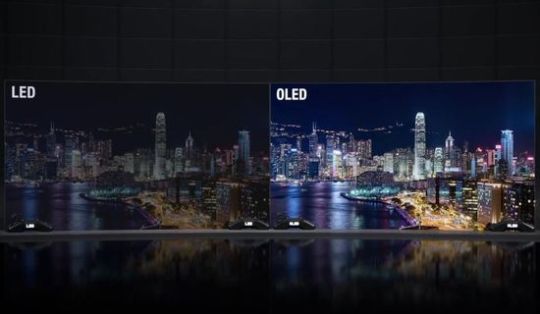
OLED vs LCD contrast But it provides relatively low brightness, which has become one of the main cons of OLED panels. Of course, its key features also include wide viewing angles, reduced panel thickness, limited range of panel sizes, disproportionate price increases for large panels, limited blue pixel life due to burn-in, etc. But the importance of these aspects is constantly decreasing. On the one hand, manufacturers of OLED panels successfully expand the range of sizes, lower prices and extending their lifespan. On the other hand, LCD panel manufacturers have also been successful in increasing viewing angles and reducing panel thickness. In fact, only excellent contrast at low brightness remain the main differences between the technologies. As known, the contrast directly affects the image quality, and peak brightness - HDR performance. In addition, the brightness is necessary to compensate for ambient lighting, for example, daylight. Samsung is also pedantically develops Micro LED technology based on self-emitting diodes without backlit. But the company chose a different path. Samsung develops Micro LED modules, which are then assembled into huge panels using magnets. At CES 2019, Samsung even showed 13-inch modules for such panels.
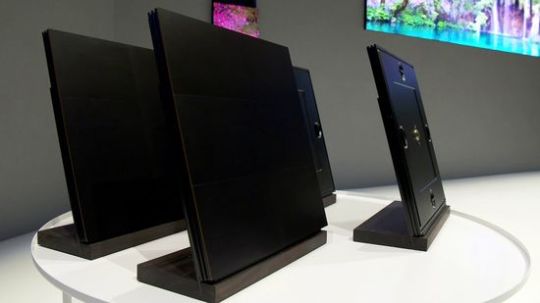
Samsung Micro LED modul This technology delivers amazing quality, but at an incredible price. For example, the 109-inch Samsung Micro LED panel at CES 2021 is worth more than $ 150,000.

Samsung Micro LED panel CES 2021
Quantum Dot technology & Local Dimming with Mini LED backlit
Of course, the LCD TVs developers weren't wasting their time either. Having developed a huge number of innovative technologies, the companies have brought LCD TV image quality very close to the level of OLED technology. Of course, QD technology and Local Dimming with Mini LED backlit dominate this list. The elegant solution of the South Korean developers gives aesthetic pleasure. As known, only sunlight provides perfect white, but conventional LEDs cannot. After a little thought, the developers decided to create an analogue of a small sun in a TV, synthesizing it from blue, green and red. This technology works as follows. Blue from blue LEDs passes through a matrix with nanoparticles, the size of which corresponds to the wavelengths of red and green. Then, the partially passed through the film blue is combined with re-reflected green and red, and they form a high-quality white, which is used to form the pixel colors.

Quantum Dots technology This technology has dramatically improved the picture quality of LCD TVs.
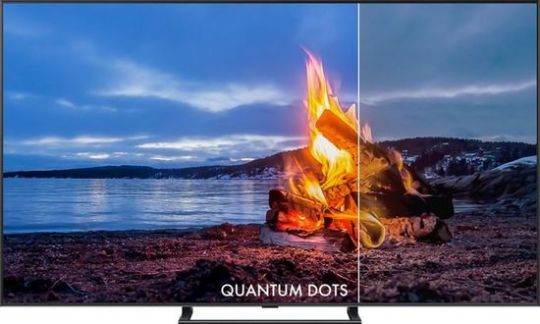
Quantum Dots image quality Companies today have developed and are using several versions of this technology, including Samsung QLED, Sony Triluminos, LG NanoCell, Hisense ULED, etc. The Mini LED backlit has significantly increased contrast by dramatically improving local dimming performance. By grouping a huge number of miniature LEDs into arrays, the developers have dramatically increased the number of independently controlled Local Dimming zones. For example, in March TCL announced a fantastic 85-inches TCL X12 8K Mini LED Starlight with 96,000 LEDs. In comparison, the legendary TCL 6-Series Roku TV (2018) used only 86 local dimming zones. As a result, the difference in price and image quality between OLED and LCD with QD technology and Mini LED backlit has practically disappeared.
LG OLED G1 TV
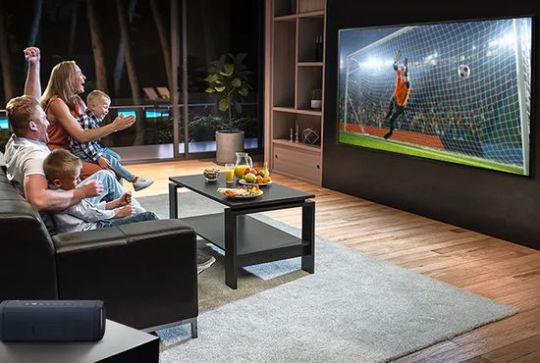
LG OLED G1 Today LG OLED G1 TV is positioned as one of the best OLED 4K TVs. The innovative bright Evo panel harmoniously complements traditionally stunning contrast of this OLED TV. The excellent webOS 6.0 with new interface, expanded Magic Explorer, enhanced LG ThinQ AI and Next Pick function is an added bonus. Finally, 4 HDMI 2.1 inputs, amazing upscaling with new α9 Gen 4 AI processor 4K, and great gaming with 4K@120Hz support, Game Optimizer, G-SYNC, FreeSync, VRR and ALLM complement its pros. Perhaps only glare due to the reflective glass surface in daylight and the absence of HDR10+ can be positioned as a small cons. On the other hand, $ 3,000 will partly offset its pros compared to other members.
Samsung Neo QLED QN90A

Samsung Neo QLED QN90A Of course, Mini LED backlit is a main feature of the new series. Tens of thousands of miniature LEDs, united in thousands of local dimming zones controlled by Samsung Quantum Matrix system, radically increase the overall image contrast by precisely adjusting the brightness in each frame fragment.

Samsung Quantum Matrix technology Moreover, the QN90A with VA panel is very bright. In particular, Dynamic Picture Mode in SDR with Standard Color Tone provides almost 1,790 nits (cd / m²) in the 10% window. But, of course, these settings slightly reduce image accuracy. The unprecedented brightness for HDR content reaches 1,600 nits, and even 1,800 nits for small bright peaks. Native contrast ratio is 3500: 1, but locall dimming increases it to around 26000: 1. The anti-glare screen perfectly suppresses reflections. The OTS+ system and 4.2.2 configuration provide a surround sound. As known, this sistem generates sound from the entire screen surface, synchronizing it with the source in the frame. The very high brightness, excellent black levels and QD technology provide very accurate color reproduction with rich colors in all brightness ranges. High native contrast ratio, exellent Mini LED FALD and wide viewing angles complement its pros. Finally, good Pre Calibration out of the box, Tizen OS with MultiView (up to 4 sources), USB camera, Smart Things, Samsung DeX and Game Bar round out the shortlist of its pros. Of course, the TV supports 4K@120Hz. But unfortunately for gamers, the model does not support the G-SYNC.
LG OLED C1
In fact, the LG OLED C1 is almost identical to the G1, but without the innovative bright Evo panel and the new built-in Next-Gen (ATSC 3.0) tuner. It also has four HDMI 2.1 ports, gorgeous new webOS 6.0, supports Dolby Vision IQ to automatically adjust brightness based on ambient lighting sensor, and all modern gaming features, inciuding HDR 4K@120Hz, VVR in Nvidia G-Sync & AMD FreeSync Premium, etc. Input lag in Standard and Boost modes does not exceed 9.4 ms. But its brightness is inferior to the G1. At its brightest Vivid mode, it shows no more than 900 nits for HDR in a 10% white window. But in general, the model provides traditionally excellent image quality and gaming performance. Like all LG TVs, it doesn't support HDR10+. As known, the company fundamentally prefers to use the Dynamic Tone Mapping mode, which actually converts HDR (High Dynamic Range) to LDR (Low Dynamic Range) to match content with model capabilities. Of course, this transformation is accompanied by losses, but it mimics our vision very effectively. Simplified, these algorithms divide all image brightness values into three levels (dark, medium, and bright), estimate the brightness of the midtones, correct the overall brightness, and redistribute the their values between pixels in the scene (dark pixels are brightened, light pixels are darkened). Then, the algorithms reduce the brightest pixels to the panel's specs. Image demonstrates their performance.

Dynamic Tone Mapping operation principle Dynamic Tone Mapping is used for the central fragment, along the edges - conventional HDR-LDR conversion. Overall, this feature is quite effective.

LG TV Dynamic Tone Mapping
LG OLED CX
The C1 is positioned as an improved version of CX. But the differences between them are minimal. They are almost identical in design.
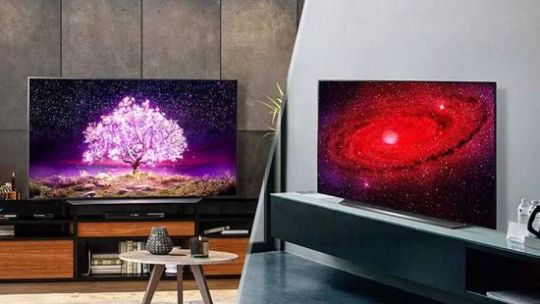
LG C1 vs CX design CX uses the last year's Magic Remote, α9 Gen 3 AI instead of the new α9 Gen 4 AI Processor 4K, and webOS 5.0 instead of the new webOS 6.0 in LG TVs 2021. Peak brightness for HDR format reaches 740 nits, the gamut coverage is 96% for DCI-P3, and 71% of Rec. 2020. Traditionally, TV provides amazing contrast and very accurate colors. The internet offers a huge number of reviews for this model, which are backed up by over 4,000 rave reviews on Amazon over several months of sales. Many experts rightly position the LG CX as the best OLED TV 2020 in terms of value for money. With a high probability, it claims to retain its place among this year's bestsellers also.
Samsung Neo QLED QN85A

Samsung QN85A Samsung QN85A is the second model in the new flagship Samsung Neo QLED line with innovative Mini LED backlit. In SDR, the TV's peak brightness reaches 1,125 nits in a 10% white window, which is more than enough to suppress glare in almost any ambient light. In HDR mode the maximum brightness reaches 1,250 nits with the maximum brightness and contrast settings in the "Movie HDR" mode (local dimming - "High", Color Tone - "Warm-2"). Moreover, “High” in Contrast Enhancer and max in ST.2084 even more boosts HDR brightness. The QN85A uses an ADS (Advanced Super Dimension Switch) panel with wide viewing angles. Unfortunately, its native contrast is 1370: 1, or 2000: 1 with local dimming. Wide color gamut is one of the pros of the new Neo QLED series. In particular, QN90A covers around 95% of color space, QN85A - 91% in DCI-P3 "xy". For DCI-P3 "uv" color space these values are 95% and 94%, respectively (adopted in 1976, "uv" chromaticity diagram takes into account sensitivity of human vision). Of course, these values are more than enough for HDR content in DCI-P3 color space. The model successfully copes with the processing of HDR content with 10 bit depth, smoothly reproducing shades without color gradients. Additionally, activating the “Noise Reduction” function almost completely eliminates possible banding in green and red shades. Unfortunately, it lowers the detail. Like the QN90A, TV has a new Game Bar feature. Its activation requires to hold Play / Pause button on remote. It shows on / off VRR mode and useful additional games info. Most importantly, Game Bar provides Super Ultra Wide Game View at 21: 9 or 32: 9 of screen ratio.

Samsung Game Bar The QN85A has one HDMI 2.1 and three HDMI 2.0 ports.
Conclusion
Of course, 65-inch $ 3,000 LG OLED G1 with innovative bright Evo panel objectively wins in this TV segment. Amazing contrast, wide color gamut, impeccable color accuracy, excellent (for OLED panel) brightness up to 1,000 nits, great new webOS 6.0, and a wide range of virtually all modern gaming features are compelling arguments in its favor. With a sufficient budget, it will be the best choice this year. Without a doubt, Sony Bravia XR A90J OLED 4K is also great, but the cost of the 65-inch model from this series reaches $ 3,800. Taking into account the minimal price difference, choosing in pairs between Samsung Neo QLED 65QN85A ($ 2,200) vs LG OLED 65CX ($ 2,000, 2020), and Samsung Neo QLED 65QN90A ($ 2,600) vs LG OLED 65C1 ($ 2,500) is more complex and ambiguous. Of course, LG OLED 65C1 is a great TV and no doubt it will compete successfully on the market. But unprecedentedly bright Samsung Neo QLED 65QN90A with excellent contrast due to innovative Mini LED backlit, and with premium specs is more than a serious competitor. With a price difference of only $ 100, its pros seem more convincing. In the budget part of our list, the Samsung Neo QLED QN85A and LG OLED CX are roughly the same. But the $ 200 difference, the expected price reduction for the LG OLED CX (2020), and most importantly, the huge amount of rave reviews give it the best marketing prospects. In general, the competition is doing its job, providing the consumer market with excellent models in all price segments. Of course, the abundance of gorgeous models often makes the choice difficult, but these chores are pleasant.
P.S.
Before posting, I accidentally found a video with information on numerous faults of new Samsung's Neo QLED TVs (total panel failure, flickering LED's, hardware faults, etc). Of course, this could be dishonest marketing or completely natural flaws in the new technology. But, in any case, this video can be useful when choosing. Read the full article
#AdvancedSuperDimensionSwitchpanel#DynamicToneMapping#GameOptimizer#LGOLEDC1#LGOLEDCX#LGOLEDG1#LGOLEDvsSamsungNeoQLED#MicroLEDpanel#MiniLEDbacklit#OLEDEvopanel#QuantumDottechnology#SamsungGameBar#SamsungNeoQLEDQN85A#SamsungNeoQLEDQN90A#SonyBraviaXRA90J#SuperUltraWideGameView#TCLX128KMiniLEDStarlight#webOS6.0
0 notes
Text
Sony Bravia XR A90J - best OLED 4K TV? Review

At $ 2,800 for the 55-inch XR55A90J model and $ 3,800 for the 65-inch XR65A90J TV, the Sony A90J can be positioned as the closest competitor to the new LG G1 OLED 4K TV with innovative Evo panel. It's slightly beterr in terms of video and audio quality, but inferior to the South Korean model in terms of advanced gaming features and price, which is $ 3,000 for a 65-inch TV. Stylish designs, including bezel-free borders, ultra-slim form-factor and brushed-metal remote, are all premium.

Sony Bravia XR A90J Design Of course, convertible stand with three options for leg placement is one of the main pros of its design.
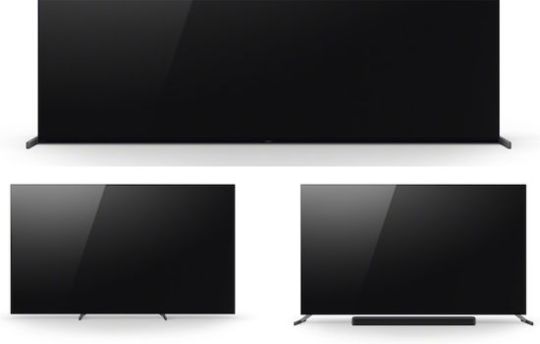
Sony Bravia XR A90J Legs This 2-way multy-position stand provides: - placement above soundbar (max height); - inverted legs (min height, tight fit to the media device without a gap); - adjustment of the distance between the legs (the legs move toward the middle of the TV, which is often very convenient). Google account and the Google Home app in the new Chromecast with Google TV provide a very simple and quick setup. Today Google TV offers 700,000+ movies and TV episodes, live TV and other content from Netflix, Amazon Prime Video, Disney+, YouTube, the Apple TV app, etc. Of course, the model uses all of Sony's innovations, including the XR Triluminos Pro display, XR OLED Contrast Pro PRO, XR 4K upscling, and supports Dolby Vision, IMAX Enhanced, Netflix Calibrated mode, Google Assistant and Apple Airplay.
Video & Audio
The video signal processing quality has also risen to a new level. For the first time the company uses a revolutionary processing technology called Cognitive Processor XR.

Sony Bravia XR A90J Cognitive Processor XR
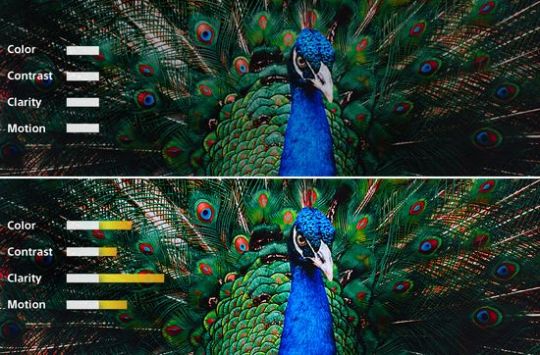
Sony Bravia XR A90J Setting

Sony Bravia XR A90J Focus Similar to the brain, the processor divides the screen into hundreds of zones, recognizes and analyzes individual objects in these zones, optimizes focal point, contrast, color and clarity for each zone, and instantly generates the most realistic overall picture. For example, the Sony XR processor can enhance the detail in animal fur without changing it for the background. Perhaps, the company's statements contain some marketing components, but the really excellent image quality fully supports them. Moreover, a new heat-sink technology for panel allows developers to increase the current without damaging the pixels. This decision nearly doubled the brightness of Sony's new OLED TV, which reached an unprecedented 1300 nits in Vivid mode. The sound is also unrivaled. As known, Sony places transducers on the back side, turning the screen surface into a speaker. This technology provides precise audio and video synchronization about the screen, dramatically increasing the immersiveness of your viewing experience.

Sony Bravia XR A90J XR Sound Position Additionally, Voice Zoom 2 detects the type of audio content, optimizing its volume and clarity.

Sony Bravia XR A90J Voice Zoom 2 What's more, XR Surround technology reproduces a 3D surround effect.
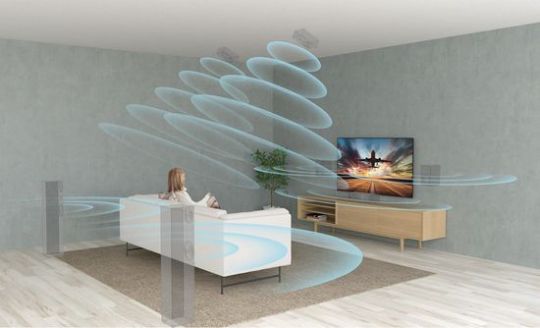
Sony Bravia XR A90J XR Surround Of course, the A90J audio cannot compete with the dedicated sub, but the additional bass driver has significantly improved bass playback. In addition, two speaker terminals on the back of A90J to accept a signal from an A / V receiver allow you to use TV as center speaker.
Picture settings & Gaming
In SDR, High peak brightness setting provides 370 nits peak. The more standard 150 nits of peak brightness setting at low provides ideal color accuracy. HDR mode actually requires no additional settings, delivering up to 800 nits brightness out of the box, which is great for Custom or Cinema modes. As usual, the slight inaccuracies of color accuracy begin to appear as peak brightness increases. But at moderate settings, it's almost perfect. Vivid mode delivers nearly 1,300 nits, but the auto-brightness limiter brings it down to less than 1,000 nits for protection of pixels from overheating. This decision is perfectly reasonable. Of course, Vivid mode is convenient for watching sports channels in bright daylight. But in other cases it looks a little unnatural and inferior to Custom or Cinema modes. The A90J has two HDMI 2.1 ports with support of 4K@120fps, ALLM (Auto low-latency mode), etc. But one port is for TV's eARC port. When using it, the TV only allows you to connect one HDMI 2.1 device. Thus, eARC must be disabled at parallel connection of, for example, Xbox Series X and PlayStation 5. However, an HDMI 2.1 4K@120fps compatible A / V receiver will solve this problem. Unfortunately, the model still does not support VRR (Variable Refresh Rate). But according to preliminary information, firmware update from Sony can eliminate this annoying disadvantage.
Sony A90J vs LG G1 OLED Evo

Sony A90J vs LG G1 - 65-inch LG G1 cheaper by $ 800; - LG G1 Gallery Series is designed for wall mounting and looks great on the wall. In addition, the included flush-mount wall bracket makes this task much easier. 2-way multy-position stand of A90J is ideal for stand mounting; - the new excellent webOS 6.0 of the LG G1 is on par with the Google TV of A90J with built-in Chromecast; - LG G1 offers a lot more built-in settings, including the great Gaming Optimizer. But using them effectively is sometimes difficult and requires skill. Overall interactive experience of A90J is simpler and more convenient; - innovative LG G1 Evo panel provides more accurate and brighter color due to purer red and blue pixels and a more accurate green pixel structure. Combined with the new α9 Gen4 processor, it delivers up to 1,000 nits brightness. New heat-sink technology in A90J increased peak brightness to an unprecedented 1,300 nits in Vivid mode, but the auto-brightness limiter brings it down to 950 nits for pixels protection from overheating; - Sony A90J with Sony's full suite of audio technologies sounds better, but the LG G1 delivers a wider range of bass; - test measurements of the LG G1 show 400 nits for SDR, 830 nits in HDR, and 860 nits in Vivid mode. The Sony A90J showcases 360 nits in SDR, 800 nits in HDR, and a unprecedented 1,250 nits in Vivid mode. But when viewing normal content in medium ambient light this difference is practically imperceptible; - today LG G1 is the best gaming TV with four HDMI 2.1 inputs, 4K@120fps, VRR, G-Sync and FreeSync support out of the box. The Gaming Optimizer completes the list of its gaming pros.
Conclusion
Pros - innovative Cognitive Processor XR technology; - brightest OLED TV today; - excellent HDR performance out of the box; - great sound with XR Sound Position, Voice Zoom 2 and XR Surround; - perfect black levels; - stunning detail; - convertible stand. Cons - $ 3,800 for 65-inch model; - eARC port uses one of two 4K@120fps HDMI 2.1 ports; - no VRR (Variable refresh rate) support in games. Of course, Sony Bravia XR A90J rightfully claims to be the best OLED 4K TV of 2021. Cognitive Processor XR technology can be positioned as the next generation of video processing. Unprecedented OLED panel brightness up to 1,300 nits, near-perfect color accuracy, great sound, a full range of innovative technologies, convertible stand, etc make up an incomplete list of its pros. Nevertheless, competitors are unlikely to provide an opportunity for the Japanese technological miracle to rest on its laurels. The new LG G1 OLED 4K TV with innovative Evo panel and webOS 6.0 is more than a serious contender. Slightly inferior in video & audio quality, South Korean TV is $ 800 cheaper and is the best gaming TV. On a high budget, the Sony Bravia XR A90J is ideal for viewing in excellent quality. But the LG G1 is a more pragmatic choice for gamers, who prefer to save money. Either way, the new level of video processing with Sony's Cognitive Processor XR technology will be a great incentive for the competition. This video showcases the innovative Cognitive Processor XR technology in the latest Sony Bravia XR A90J TVs. Read the full article
#CognitiveProcessorXRtechnology#LGG1OLEDEvoTV#OLEDEvopanel#SonyBraviaXRA90J#SonyBraviaXRA90JOLED4KTV#SonyVoiceZoom2#SonyXRSurround#XRSoundPosition
0 notes